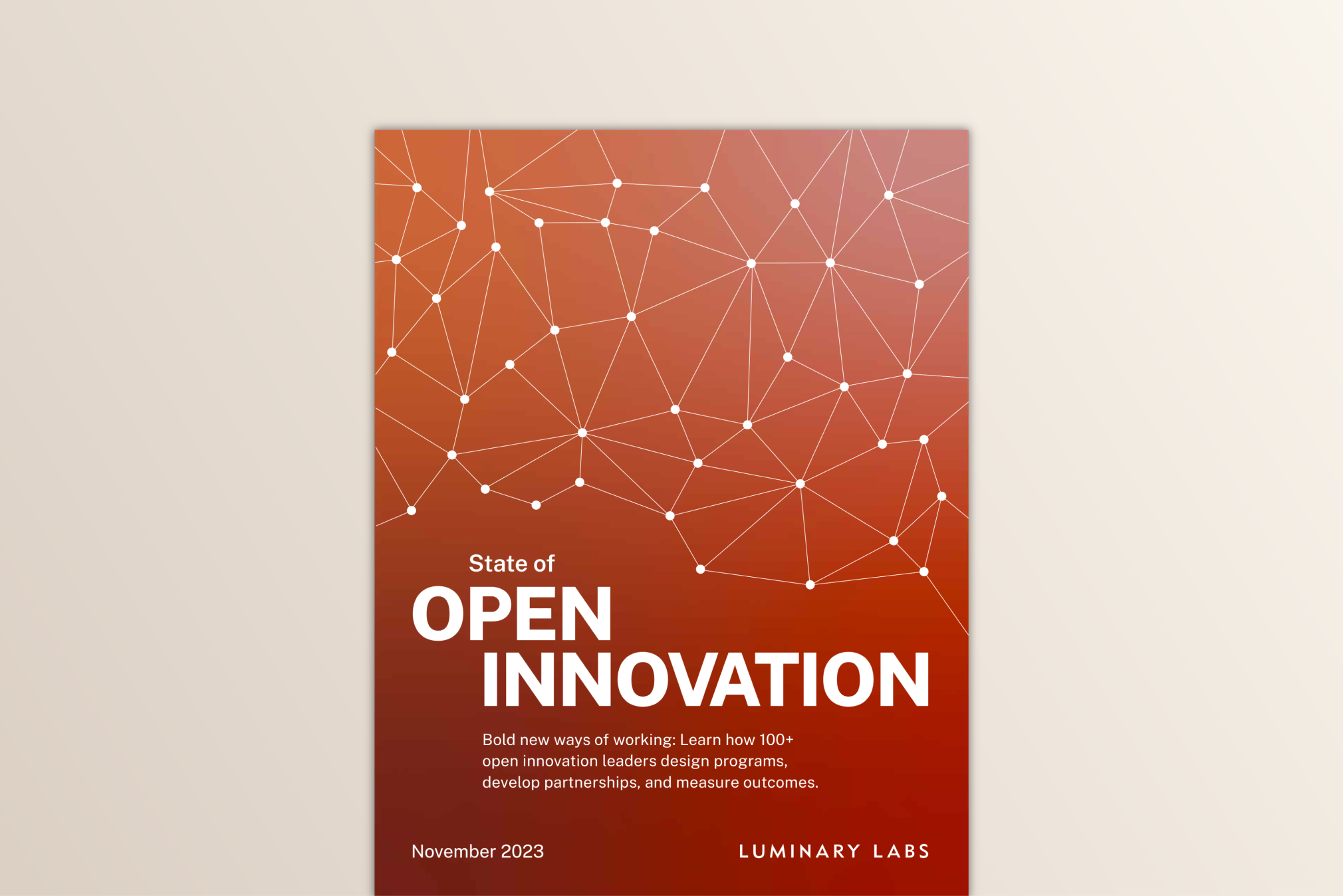Learn how 100+ leading organizations are using open innovation to stay at the forefront.
Our latest report offers fresh insights into collaboration, outcomes, and investment in open innovation.
Open innovation plays an important role in business, government, and society: solving global challenges, accelerating product development, and stimulating new markets. Luminary Labs’ State of Open Innovation 2023 — a follow-up to our inaugural 2018 report — examines open innovation’s current role in organizations, identifies shifts and trends, and looks at what the future might hold.
Download the 2023 report for 50+ pages of analysis and benchmarks — including insights from open innovation leaders at AstraZeneca, Bayer, MIT Solve, NASA, the National Institutes of Health, Siegel Family Endowment, the U.S. Department of Veterans Affairs, the University of Chicago, and the Walton Family Foundation.
Download the report:
The role of open innovation in an ever-changing world
It’s been 20 years since Berkeley professor Dr. Henry Chesbrough first defined the term “open innovation.” And it’s been five years since Luminary Labs published the inaugural State of Open Innovation report, a landmark cross-sector survey of nearly 100 open innovation leaders. Our 2018 survey asked leaders in private-sector, government, and nonprofit organizations to share how they were using open innovation — from co-creation, participatory design, and crowdsourcing to prize competitions, hackathons, and accelerators — to surface new solutions to complex problems.
The world has changed dramatically since we published our first report. The COVID-19 pandemic accelerated digital transformation for anyone who wasn’t already on the bandwagon. Organizations rapidly adapted to what it means to be distributed, then adapted again to create new hybrid work environments. Following the Great Reshuffle, talent and expertise have shifted. Society at large has developed a better understanding of diversity, equity, and inclusion — and is reckoning with what it means to advance DEI within organizations and industries. The urgency of the pandemic moment called for — and elevated — non-traditional approaches such as open innovation, advance market commitments, and emergency use authorizations.
All of this means we’re operating in a much different world than the one we knew before. And in this new world, there’s growing awareness of open innovation and recognition of its potential to solve previously unsolvable challenges. As we look to the future — the next five years, or even the next 20 years — we expect more “unprecedented” moments. Demographics are shifting, and the world’s population is aging. Our infrastructure is also aging, and we’ll need to solve major climate-related problems. Open innovation will be essential to helping humanity move forward.
This year, we invited more than 100 leaders to share fresh insights into collaboration, outcomes, and investment in open innovation. Overall, we observed a notable shift in sentiment; five years after our inaugural survey, leaders seem more confident in their approaches to open innovation and its ability to produce meaningful outcomes.
Our 2023 survey and in-depth interviews with open innovation leaders uncovered several emergent trends.
- Elevating open innovation. No longer on the fringes, open innovation is accepted as a method to solve core business problems.
- Building capacity. A focus on talent and internal collaboration strengthens open innovation across the organization.
- Embracing the power of partnership. Relationships with external organizations scale open innovation’s impact.
Of course, there is always room for growth. Leading practitioners offered ideas for overcoming common barriers and further advancing open innovation by focusing on key opportunities.
- Innovator-centered design. Carefully considered program elements — from incentives to outreach — can help a diverse community of innovators advance their best ideas.
- Strategic storytelling. A thoughtful balance of strategy, metrics, and narrative can help leaders win support for open innovation.
- Amplified ingenuity. An eye toward the future of open innovation can help organizations stay one step ahead.
Five years ago, collaboration was “the new competitive edge.” Now, partnership is a prerequisite, and open innovation is essential to keeping pace in a rapidly changing world. We have never felt more optimistic about the future of open innovation or more inspired to be part of the global community of open innovation leaders.

